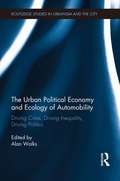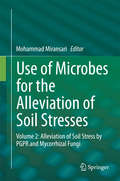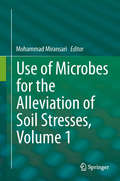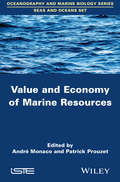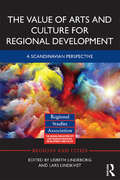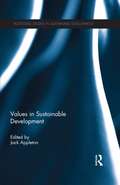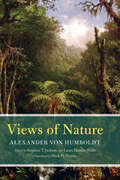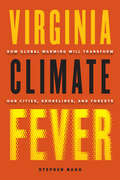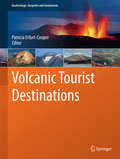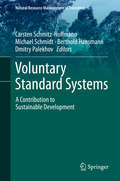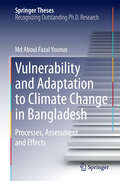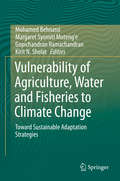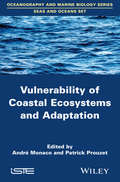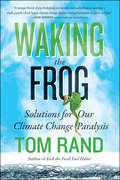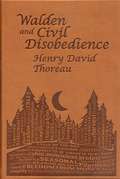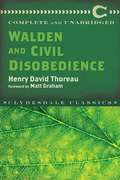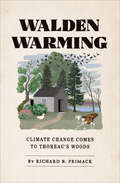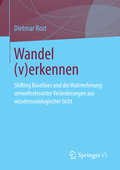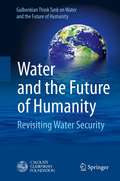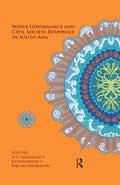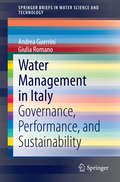- Table View
- List View
The Urban Political Economy and Ecology of Automobility: Driving Cities, Driving Inequality, Driving Politics (Routledge Studies in Urbanism and the City)
by Alan WalksJust how resilient are our urban societies to social, energy, environmental and/or financial shocks, and how does this vary among cities and nations? Can our cities be made more sustainable, and can environmental, economic and social collapse be staved off through changes in urban form and travel behaviour? How might rising indebtedness and the recent series of financial crises be related to automobile dependence and patterns of urban automobile use? To what extent does the system and economy of automobility factor in the production of urban socio-spatial inequalities, and how might these inequalities in mobility be understood and measured? What can we learn from the politics of mobility and social movements within cities? What is the role of automobility, and auto-dependence, in differentiating groups, both within cities and rural areas, and among transnational migrants moving across international borders? These are just some of the questions this book addresses. This volume provides a holistic and reflexive account of the role played by automobility in producing, reproducing, and differentiating social, economic and political life in the contemporary city, as well as the role played by the city in producing and reproducing auto-mobile inequalities. The first section, titled Driving Vulnerability, deals with issues of global importance related to economic, social, financial, and environmental sustainability and resilience, and socialization. The second section, Driving Inequality, is concerned with understanding the role played by automobility in producing urban socio-spatial inequalities, including those rooted in accessibility to work, migration status and ethnic concentration, and new measures of mobility-based inequality derived from the concept of effective speed. The third section, titled, Driving Politics, explores the politics of mobility in particular places, with an eye to demonstrating both the relevance of the politics of mobility for influencing and reinforcing actually existing neoliberalisms, and the kinds of politics that might allow for reform or restructuring of the auto-mobile city into one that is more socially, politically and environmentally just. In the conclusion to the book Walks draws on the findings of the other chapters to comment on the relationship between automobility, neoliberalism and citizenship, and to lay out strategies for dealing with the urban car system.
Use of Microbes for the Alleviation of Soil Stresses
by Mohammad MiransariUse of Microbes for the Alleviation of Soil Stresses, Volume 2: Alleviation of Soil Stress by PGPR and Mycorrhizal Fungi describes the most important details and advances related to the alleviation of soil stresses by PGPR and mycorrhizal fungi. Comprised of eleven chapters, the book reviews the role of arbuscular mycorrhizal fungi in alleviation of salt stress, the role of AM fungi in alleviating drought stress in plants, the impact of biotic and abiotic stressors and the use of mycorrhizal fungi to alleviate compaction stress on plant growth. Written by experts in their respective fields, Use of Microbes for the Alleviation of Soil Stresses, Volume 2: Alleviation of Soil Stress by PGPR and Mycorrhizal Fungi is a comprehensive and valuable resource for researchers and students interested in the field of microbiology and soil stresses.
Use of Microbes for the Alleviation of Soil Stresses, Volume 1
by Mohammad MiransariUse of Microbes for the Alleviation of Soil Stresses, Volume 1 describes the most important details and advances related to the alleviation of soil stresses by soil microbes. Comprised of seven chapters, the book reviews the mechanisms by which plant growth promoting rhizobacteria (PGPR) alleviate plant growth under stress; the role of mycorrhizal fungi on the alleviation of drought stress in host plants; how PGPR may alleviate salinity stress on the growth of host plants; and the role of PGPR on the growth of the host plant under the stress of sub optimal root zone temperature. Written by experts in their respective fields, Use of Microbes for the Alleviation of Soil Stresses, Volume 1 is a comprehensive and valuable resource for researchers and students interested in the field of microbiology and soil stresses.
Value and Economy of Marine Resources
by André Monaco Patrick ProuzetMarine resources and their exploitation, recovery and economic networks they generate are here from the perspective now inevitable growing environmental constraints, policy management and technical innovation.The recent development of marine biotechnology , the discovery of a great pharmacopoeia especially in reef environments , the development of marine renewables , are examples which show that man can develop through these new technologies property and services of the ocean.But this development resources under pressure of global change requires not only taking into account technical, but also social and political. This is the price that the analysis of maritime activities will assess the sustainability and development of various economic sectors and coastal populations, faced with the objectives of a "blue growth" associated with a return to the "good state "of the marine environment.
The Value of Arts and Culture for Regional Development: A Scandinavian Perspective (Regions and Cities #64)
by Lisbeth Lindeborg Lars LindkvistIn this new volume, 28 Scandinavian researchers and others who are active in arts and culture seek to answer the questions: What has been the effect of regional and local investment in arts and culture? And what positive and negative experiences have there been? This book describes and analyzes the extent to which cultural investments at local and regional levels have stimulated development and led to essential processes of change for the community in general. Of special interest is how different places manage to "turn the tide". What do their development processes involve? Which ways and means do they use to go forward in order to change their paths and start anew? These are just a few of the important questions addressed in this book. One of the most important findings is that while you can never transfer the successful renewal of one place to another like a blueprint, certain common patterns in the cultural processes are discernible. The contributors to this book show the breadth of theoretical tools that can be used to increase awareness of the significance of culture for regional development. Throughout the book readers will find a multitude of theoretical concepts, from entrepreneurship theory, organizational institutionalism and cultural economy, to cultural planning and art management. This book will appeal to scholars and practitioners of urban and regional studies, and cultural and creative economics.
Values in Sustainable Development: Values In Sustainable Development (Routledge Studies in Sustainable Development)
by Jack AppletonTo enhance sustainable development research and practice the values of the researchers, project managers and participants must first be made explicit. Values in Sustainable Development introduces and compares worldviews and values from multiple countries and perspectives, providing a survey of empirical methods available to study environmental values as affected by sustainable development. The first part is methodological, looking at what values are, why they are important, and how to include values in sustainable development. The second part looks at how values differ across social contexts, religions and viewpoints demonstrating how various individuals may value nature from a variety of cultural, social, and religious points of view. The third and final part presents case studies ordered by scale from the individual and community levels through to the national, regional and international levels. These examples show how values can motivate, be incorporated into and be an integral part of the success of a project. This thought-provoking book gives researchers, students and practitioners in sustainable development a wealth of approaches to include values in their research.
Views of Nature
by Laura Dassow Walls Alexander Von Humboldt translated by Mark W. Person edited by Stephen T. JacksonPurchase of this book includes free trial access to www. million-books. com where you can read more than a million books for free. This is an OCR edition with typos. Excerpt from book: Modern views on the mountain systems of the two American peninsulas. Chains, which have a direction from S. W. to N. E. , in Brazil and in the Atlantic portion of the United States of North America. Depression of the Province of Chiquitos; ridges as watermarks between the Guapor6 and Aguapehi in 15 and 17 south lat. , and between the fluvial districts of the Orinoco and Eio Negro in 2 and 3 north lat. ?pp. 29-31. Continuation of the Andes-chain north of the isthmus of PanamS through the territory of the Aztecs, (where the Popocatepetl, recently ascended by Capt. Stone, rises to an altitude of 17,720 feet, ) and through the Crane and Rocky Mountains. Valuable scientific investigations of Capt. Fremont. The greatest barometric levelling ever accomplished, representing a profile of the ground over 28 of longitude. Culminating point of the route from the coast of the Atlantic to the South Sea. The South Pass southward of the Wind-River Mountains. Swelling of the ground in the Great Basin. Long disputed existence of Lake Timpanogos. Coast-chain, Maritime Alps, Sierra Nevada of California. Volcanic eruptions. Cataracts of the Columbia River?pp. 31-38. General considerations on the contrast between the configuration of the territorial spaces, presented by the two diverging coast-chains, east and west of the central chain, called the Rocky Mountains. Hypsometric constitution of the Eastern Lowland, which is only from 400 to somewhat more than 600 feet above the level of the sea, and of the arid uninhabited plateau of the Great Basin, from 5000 to more than 6000 feet high. Sources of the Mississippi in Lake Istaca according to Nicollet, whose labours are most meritorious. Native land of the Bisons; their ancient domestication in Northern Mexico asserted by Gomara?pp. 38-42. Retrospectiv. .
Virginia Climate Fever: How Global Warming Will Transform Our Cities, Shorelines, and Forests
by Stephen NashClimate disruption is often discussed on a global scale, affording many a degree of detachment from what is happening in their own backyards. Yet the consequences of global warming are of an increasingly acute and serious nature.In Virginia Climate Fever, environmental journalist Stephen Nash brings home the threat of climate change to the state of Virginia. Weaving together a compelling mix of data and conversations with both respected scientists and Virginians most immediately at risk from global warming's effects, the author details how Virginia's climate has already begun to change. In engaging prose and layman's terms, Nash argues that alteration in the environment will affect not only the state's cities but also hundreds of square miles of urban and natural coastal areas, the 60 percent of the state that is forested, the Chesapeake Bay, and the near Atlantic, with accompanying threats such as the potential spread of infectious disease. The narrative offers striking descriptions of the vulnerabilities of the state's many beautiful natural areas, around which much of its tourism industry is built.While remaining respectful of the controversy around global warming, Nash allows the research to speak for itself. In doing so, he offers a practical approach to and urgent warning about the impending impact of climate change in Virginia.
Volcanic Tourist Destinations
by Patricia Erfurt-CooperThis comprehensive book addresses the pressing need for up-to-date literature on volcanic destinations (active and dormant) and their role in tourism worldwide in chapters and case studies. The book presents a balanced view about the volcano-based tourism sector worldwide and discusses important issues such as the different volcanic hazards, potential for disasters and accidents and safety recommendations for visitors. Individual chapters and case studies are contributed by a number of internationally based co-authors, with expertise in geology, risk management, environmental science and other relevant disciplines associated with volcanoes. Also covered are risk aspects of volcano tourism such as risk perception, risk management and public safety in volcanic environments. Discussions of the demand for volcano tourism, including geotourism and adventure tourism as well as some historical facts related to volcanoes, with case studies of interesting socio-cultural settings are included.
Voluntary Standard Systems
by Carsten Schmitz-Hoffmann Michael Schmidt Berthold Hansmann Dmitry PalekhovEmerging to the forefront of sustainable production and consumption are a promising and rapidly evolving concept known as Voluntary Standard Systems (VSS). They encompass the three pillars of sustainability - social, environmental and economic aspects and consequently they can be considered as a tool, which makes sustainable development visible. Currently, they are becoming a significant element in international trade and in the promotion of sustainable development strategies, especially in the context of globalised markets and supply chains. This volume provides a comprehensive overview of the current VSS concepts: from their nature and functioning, to the future outlook for their development. It places VSS in the broader context of global development issues and challenges, including development policy and international sustainability commitments, progress towards achieving 'green economy' and meeting climate protection targets. The volume contains also a representative selection of case studies which demonstrate their wide range of application in different sectors of the economy.
The Voyageur Canadian History 2-Book Bundle: The Refugee / The Letters and Journals of Simon Fraser, 1806-1808
by W. Kaye Lamb Benjamin Drew George E. ClarkeVoyageur Classics is a series that issues special new versions of Canadian classics, with added material and special introductions. In this bundle we find two classic works of Canadian historical writing. During three extraordinary years, 1805-1808, Simon Fraser undertook the third major expedition across North America, culminating in his famous journey down the river in British Columbia that now bears his name. Fraser’s exploratory efforts helped lead to Canada’s boundary later being declared at the 49th parallel. In this new volume, librarian and archivist W. Kaye Lamb provides a detailed introduction as well as illuminating annotations to Fraser’s journals. In the early 1850s, white American abolitionist Benjamin Drew was commissioned to travel to Canada West (now Ontario) to interview escaped slaves from the United States. In the course of his journeys in Canada, Drew visited Chatham, Toronto, Galt, Hamilton, London, Dresden, Windsor, and a number of other communities. Originally published in 1856, Drew’s book is the only collection of first-hand interviews of fugitive slaves in Canada ever done. It is an invaluable record of early black Canadian experience. Includes The Refugee The Letters and Journals of Simon Fraser, 1806-1808
Vulnerability and Adaptation to Climate Change in Bangladesh
by Md Aboul Fazal YounusThe IPCC (2007) warned that the Ganges Brahmaputra Meghna (GBM) basin will be at greatest risk due to increased flooding, and that the region's poverty would reduce its adaptation capacity. This book investigates autonomous adaptation using a multi-method technique comprising PRA and a questionnaire survey applied in the case study area 'Islampur' Upazila in Bangladesh. The study has four key approaches. First, it reviews the flood literature for Bangladesh from 1980 to 2014. Second, it examines farmers' crop adaptation processes in a case study area at Islampur, Bangladesh. Third, it assesses the vulnerability and adaptation (V & A) in response to three extreme flood events (EFEs). Fourth, the book assesses the economic consequences of failure effects of autonomous crop adaptation in response to EFEs. The results show that Bangladeshi farmers are highly resilient to EFEs, but the economic consequences of failure effects of autonomous crop adaptation (FEACA) on marginal farmers are large. The book contributes to current knowledge by filling three important research gaps as follows, 1) farmers' autonomous crop adaptation processes in response to various types of extreme floods; 2) methodological contribution for assessing vulnerability and adaptation through PRA; and 3) the economic consequences of the failure effects of autonomous crop adaptations. "This book provides a good account of 'autonomous adaptation' and its impact on fl ood vulnerable communities in Bangladesh. Anyone wishing to fully understand the impact of climate change should read the book. " Professor Muhammad Yunus, Nobel Laureate, Yunus Centre, Bangladesh
Vulnerability of Agriculture, Water and Fisheries to Climate Change
by Mohamed Behnassi Margaret Syomiti Muteng'E Gopichandran Ramachandran Kirit N. ShelatHuman activity is changing the global environment at an unprecedented rate while humanity faces a range of complex and interrelated challenges to local, regional and global development, human security and politics. Food security ranks high on the science, policy and development agendas. However, most research linking global change and food systems examines the impact of climate change on agricultural production, or the impact of agriculture on land use, pollution and biodiversity, overlooking interactions with other aspects of the food system - such as food processing, packaging, transportation and consumption and employment derived from these activities. This book demonstrates that new threats to food security which arise from environmental change require more than simply a focus on agricultural practices - what is needed is an integrated food system approach. The authors point out that the process of adapting food systems to global environmental change is not simply a search for technological solutions to increase agricultural yields. Tradeoffs across multiple scales among food system outcomes are a prevalent feature of globalized food systems. Within food systems, there are key underexplored areas that are both sensitive to environmental change and crucial to understanding its implications for food security and adaptation strategies. The authors assert that technical prescriptions alone will not efficiently manage the food security challenge. This book is their contribution to a new paradigm, which addresses food systems holistically by engaging researchers in multiple disciplines to understand the causes and drivers of vulnerability.
Vulnerability of Coastal Ecosystems and Adaptation
by André Monaco Patrick ProuzetThe vulnerability of socio -ecosystem combines the probability of exposure to natural or anthropogenic pressure, sensitivity and resilience. This book presents a systemic view of the diversity of pressures and impacts produced by climate change and human actions. Erosion of biodiversity by changing ocean chemistry, the intensification of global change raises the problem of the adaptation of living resources.
Waking the Frog: Solutions for Our Climate Change Paralysis
by Tom Rand<p>A venture capitalist, entrepreneur, and engineer, Tom Rand looks to contemporary psychology, economics, business, and finance to explain our difficulty in confronting one of the most fundamental problems of our time. Rand’s account doesn’t just point fingers at the bad guys, but goes deeper—to our motivations, institutional lethargy, and deeply buried assumptions about market economics. <p>Waking the Frog reveals that our ingenuity, technology, capital, and policy can work together to turn down the heat—and at the same time enable the largest economic opportunity of the twenty-first century. </p>
Walden and Civil Disobedience (Wordsworth Classics)
by Henry David ThoreauThe oft-quoted transcendentalist Henry David Thoreau is best known for two works: Walden and Civil Disobedience. Walden, first published in 1854, documents the time Thoreau spent living with nature in a hand-built cabin in the woods near Walden Pond in Massachusetts. A minor work in its own time, Walden burgeoned in popularity during the counter culture movement of the 1960s. Civil Disobedience is thought to have originated after Thoreau spent a night in jail for refusing to pay taxes to a government with whose policies he did not agree. Assigning greater importance to the conscience of the individual than the governing law, Civil Disobedience is an internationally admired work that is known to have influenced writer Leo Tolstoy and political activist Mahatma Gandhi, and many members of the American Civil Rights Movement. Now available together in one chic and affordable edition as part of the Word Cloud Classics series, Walden and Civil Disobedience makes an attractive addition to any library
Walden and Civil Disobedience (First Avenue Classics Ser.)
by Henry David Thoreau Matt GrahamPackaged in handsome, affordable trade editions, Clydesdale Classics is a new series of essential works. From the musings of academics such as Thomas Paine in Common Sense to the striking personal narrative of Harriet Jacobs in Incidents in the Life of a Slave Girl, this new series is a comprehensive collection of our intellectual history through the words of the exceptional few.First published in 1854, Walden was written by the renowned transcendentalist Henry David Thoreau about his experience living off the land at Walden Pond for more than two years. Thoreau divides his deliberations and meditations into a variety of sections which include his views on economy and the natural world, the importance of reading and literature, the values of both solitude and companionship, and other personal reflections. In addition to Walden, this edition also includes Thoreau’s essay on Civil Disobedience, which discusses his views on the nature of government and its negative effects on society.With a new foreword by survivalist Matt Graham, venture into the woods with Thoreau and explore the complexities of life and truth in this classic piece of American literature.
Walden Warming: Climate Change Comes to Thoreau's Woods
by Richard B. PrimackIn his meticulous notes on the natural history of Concord, Massachusetts, Henry David Thoreau records the first open flowers of highbush blueberry on May 11, 1853. If he were to look for the first blueberry flowers in Concord today, mid-May would be too late. In the 160 years since Thoreau’s writings, warming temperatures have pushed blueberry flowering three weeks earlier, and in 2012, following a winter and spring of record-breaking warmth, blueberries began flowering on April 1--six weeks earlier than in Thoreau’s time. The climate around Thoreau’s beloved Walden Pond is changing, with visible ecological consequences. In Walden Warming, Richard B. Primack uses Thoreau and Walden, icons of the conservation movement, to track the effects of a warming climate on Concord’s plants and animals. Under the attentive eyes of Primack, the notes that Thoreau made years ago are transformed from charming observations into scientific data sets. Primack finds that many wildflower species that Thoreau observed--including familiar groups such as irises, asters, and lilies--have declined in abundance or have disappeared from Concord. Primack also describes how warming temperatures have altered other aspects of Thoreau’s Concord, from the dates when ice departs from Walden Pond in late winter, to the arrival of birds in the spring, to the populations of fish, salamanders, and butterflies that live in the woodlands, river meadows, and ponds. Primack demonstrates that climate change is already here, and it is affecting not just Walden Pond but many other places in Concord and the surrounding region. Although we need to continue pressuring our political leaders to take action, Primack urges us each to heed the advice Thoreau offers in Walden: to "live simply and wisely. ” In the process, we can each minimize our own contributions to our warming climate.
Walden Warming: Climate Change Comes to Thoreau's Woods
by Richard B. PrimackIn his meticulous notes on the natural history of Concord, Massachusetts, Henry David Thoreau records the first open flowers of highbush blueberry on May 11, 1853. If he were to look for the first blueberry flowers in Concord today, mid-May would be too late. In the 160 years since Thoreau’s writings, warming temperatures have pushed blueberry flowering three weeks earlier, and in 2012, following a winter and spring of record-breaking warmth, blueberries began flowering on April 1—six weeks earlier than in Thoreau’s time. The climate around Thoreau’s beloved Walden Pond is changing, with visible ecological consequences. In Walden Warming, Richard B. Primack uses Thoreau and Walden, icons of the conservation movement, to track the effects of a warming climate on Concord’s plants and animals. Under the attentive eyes of Primack, the notes that Thoreau made years ago are transformed from charming observations into scientific data sets. Primack finds that many wildflower species that Thoreau observed—including familiar groups such as irises, asters, and lilies—have declined in abundance or have disappeared from Concord. Primack also describes how warming temperatures have altered other aspects of Thoreau’s Concord, from the dates when ice departs from Walden Pond in late winter, to the arrival of birds in the spring, to the populations of fish, salamanders, and butterflies that live in the woodlands, river meadows, and ponds. Primack demonstrates that climate change is already here, and it is affecting not just Walden Pond but many other places in Concord and the surrounding region. Although we need to continue pressuring our political leaders to take action, Primack urges us each to heed the advice Thoreau offers in Walden: to “live simply and wisely.” In the process, we can each minimize our own contributions to our warming climate.
Wandel (v)erkennen
by Dietmar RostAngemessene Antworten auf die Problematik von Klimawandel und Artenschwund verlangen eine gesellschaftliche Wahrnehmung von langfristigen Veränderungen in Natur und Gesellschaft. Das Buch fragt nach den Formen, Grenzen und Konsequenzen der individuellen und kollektiven Wahrnehmung von Wandel und eröffnet ein wissenssoziologisch fundiertes Verständnis der (Nicht-)Wahrnehmung vergangener wie auch zukünftiger Veränderungsprozesse. Dies erfolgt zunächst in einer theoretischen Perspektive durch die Zusammenführung von relevanten Gesichtspunkten aus der Erinnerungs-, Generationen- und Zeitforschung. Das Konzept der ,,Shifting Baselines" liefert hierfür einen Ausgangspunkt. Daran anschließend blickt das Buch anhand von Aufschlüssen aus qualitativen Interviews auf die Wahrnehmung von Wandlungsprozessen unterschiedlicher Dynamik - von langsamem, rapidem und krassem (d. h. katastrophischem) Wandel -, um schließlich die Frage der Varianz und historischen Veränderung der Wahrnehmung von Wandel zu diskutieren.
Wann bekommen die Küstenbewohner denn nun nasse Füße?
by Rüdiger SchachtAlltagsleben und Wissenschaft - ein ,,wunderbares" Beispiel für Parallelgesellschaften und in vielen Fällen ein Kommunikationsdesaster erster Güte: Längst versteht der Mensch auf der Straße den Wissenschaftler nicht mehr. Gerade am Beispiel der zum Teil hochemotional besetzten Debatte um die Klimaforschung zeigt sich, wie weit die beiden Welten auseinanderklaffen. Die vielfach schlechte Kommunikation der Methoden und Ergebnisse der Klimaforschung und die mediale Überspitzung der Vergangenheit rächen sich und kaum ein Mensch außerhalb des Wissenschaftsbetriebs überblickt noch die Methoden und Facetten der Klimaforschung. So versucht das vorliegende Buch die Debatte um die Klimaforschung wieder auf die Sach- und Faktenebene zu ziehen und einmal nachzuschauen, auf welchen Methoden die Ergebnisse der modernen Klimaforschung eigentlich fußen. Woher stammen die Daten, wie kann man die Ergebnisse zusammenführen und wie sehen die Schlussfolgerungen aus? Führende Klimaforscher schildern ihren Ansatz, der von der Datenerhebung bis zu den Klimamodellen reicht - und darüber hinaus! Mit einem Nachwort von Prof. Dr. Mojib Latif.
Wärmeschutz und Heizungstechnik: Ein Überblick (essentials)
by Bernd Schröder Ekbert HeringBeim Wärmeschutz im Hochbau werden Maßnahmen getroffen, um in beheizten Gebäuden ein für Menschen behagliches Raumklima zu schaffen. Grundlegend ist hierzu die Wärmebewegung durch Bauteile, die es zu berechnen gilt. Mindestanforderungen an den Wärmeschutz im Winter sind nach DIN geregelt. Im Bereich der Heizungstechnik unterscheidet man Einzelheizgeräte für Wohnräume, größere Räume und Hallen. Für die Zentralheizung gibt es je nach Wärmeträger unterschiedliche Systeme. Heizkörper und Heizflächen treten in verschiedenen Ausführungen auf. Neben dem hierfür notwendigen Rohrnetz sind noch Armaturen und meist Umwälzpumpen nötig. Die Wärmeerzeugung erfolgt in Heizkesseln, eventuell unterstützt durch Wärmepumpen und Sonnenkollektoren. Auch Fernheizungen haben sich stellenweise etabliert.
Water and the Future of Humanity
by Springer International PublishingThis unique, engaging, and highly authoritative volume enlightens readers on changes needed in the way society accesses, provides, and uses water. It further shines a light on changes needed in the way we use food, energy, and other goods and services in relation to water, and offers projections and recommendations, up to 2050, that apply to water access challenges facing the poor and the common misuse of water in industry, agriculture, and municipalities. Written by an unparalleled slate of experts convened by the Calouste Gulbenkian Foundation, the book takes on one of the most critical issues on the planet today. In a frank yet optimistic assessment of major developmental challenges, but also opportunities, facing future generations, the author elucidates linkages between water and a range of other drivers from various disciplinary and stakeholder perspectives. Ultimately portraying the belief that Humanity can harness its visionary abilities, technologies, and economic resources for increased wellbeing and sound stewardship of resources, the book presents an optimistic statement stressing actions scientists, policy makers, and consumers can and must take to meet the water management challenges of a warming planet anticipating nine billion inhabitants by 2050. Gulbenkian Think Tank on Water and the Future of Humanity: Benedito Braga, Pres. World Water Council & Prof. of Civil Engineering, Univ. of São Paulo, Brazil; Colin Chatres, Director General of the International Water Management Institute, Sri Lanka; William J. Cosgrove, Pres. of Ecoconsult Inc. & Senior Adviser for the UN World Water Development Report, Canada; Luis Veiga da Cunha, Prof. Environmental Science and Engineering, Universidade Nova de Lisboa, Portugal; Peter Gleick, Pres. of the Pacific Institute, USA; Pavel Kabat, Director, International Institute for Applied Systems Analysis, Austria; and Prof. & Chair, Earth Systems Science, Wageningen University, The Netherlands; Mohamed Ait Kadi, President of the General Council of Agricultural Development, Morocco; Daniel P. Loucks, Prof. of Civil Engineering, Cornell Univ. USA; Jan Lundqvist, Senior Scientific Advisor, Stockholm International Water Institute, Sweden; Sunita Narain, Director, Center for Science & Environment, New Delhi, India; Jun Xia, Pres. , International Water Resources Association, Chair Prof. & Dean, The Research Institute for Water Security (RIWS), Wuhan University, China.
Water Governance and Civil Society Responses in South Asia
by N. C. Narayanan S. Parasuraman Rajindra AriyabanduThis book addresses paradigm shifts in water policy and governance, and examines the role of civil society organizations in influencing public policy, while focusing on social equity and democratic participation. It illustrates a range of interesting developments in policy formulation, donor–state nexus, and interventions by civil society and voluntary organizations. The collection of articles provides a comprehensive and current narrative of the state–society relations in South Asia under neoliberal governance reforms, their implications and key responses with regard to water policies. Using case studies, it closely investigates the impact, effectiveness, drawbacks and challenges faced by voluntary organizations and social movements working at various levels in the water sector. The work will interest researchers and students of development studies, environmental studies, natural resource management, water governance, and public administration, as also water sector professionals, policymakers, civil society activists and governmental and non-governmental organizations.
Water Management in Italy
by Andrea Guerrini Giulia RomanoThis book describes the water sector as it is structured in Italy. The first part describes the legal framework which rules the sector in Italy, its evolution since the last 20 years, and its weaknesses. The second part describes the governance of Italian water utilities, distinguishing full public-owned companies from public-private partnership and private companies. The third part reports insights on water utilities performance to enquire the presence of economies by scope, scale and density in the Italian water sector, and to verify the presence of any differences in terms of efficiency and tariffs among public and private firms. The fourth part describes the investment policies carried out by water utilities, observing the total amount of per capita investments and the actual realization of planned investments. The fifth part describes if and how utilities applied water conservation practices to incentive the sustainable water use.
